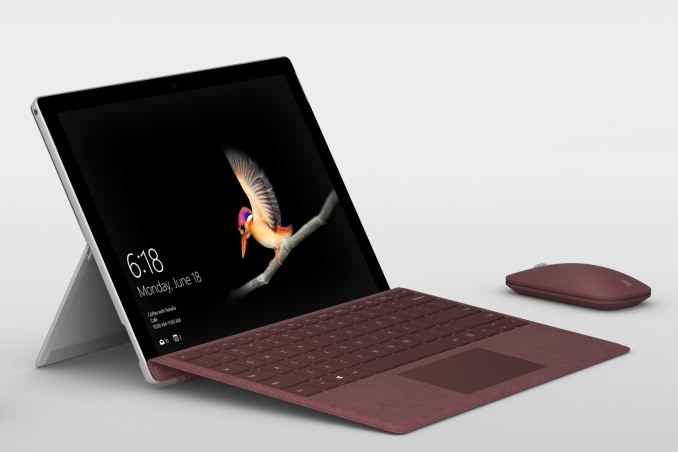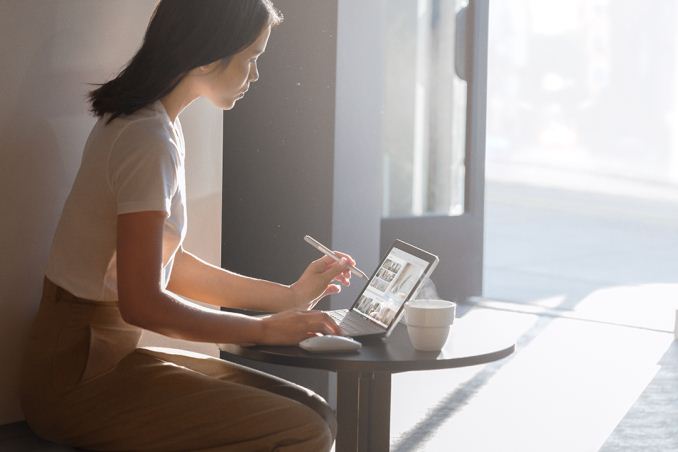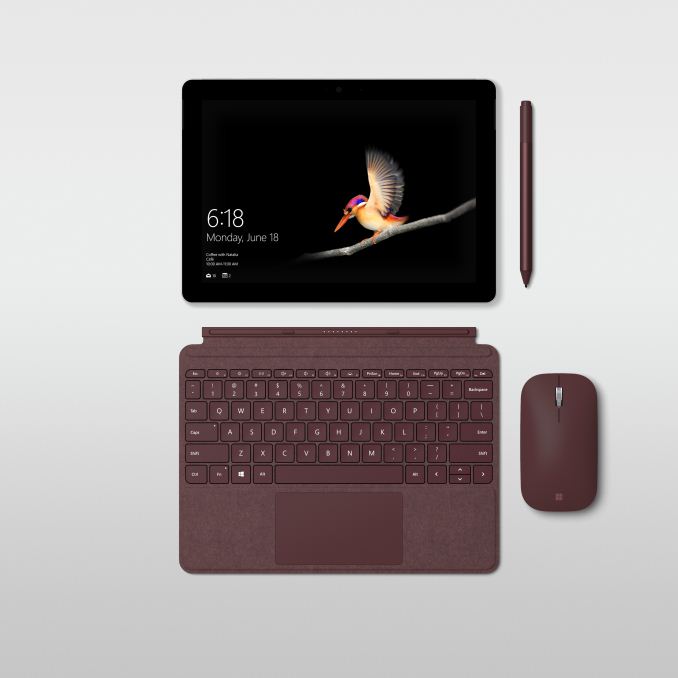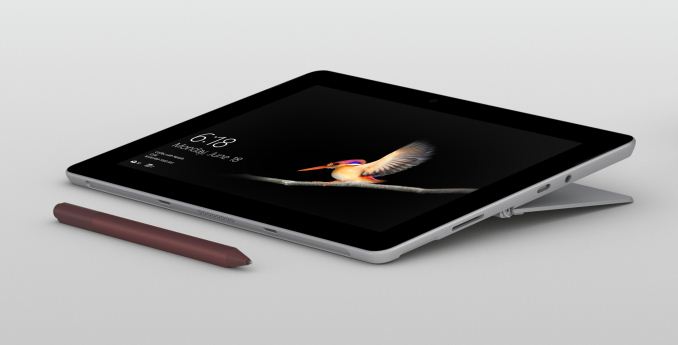Microsoft Announces The Surface Go: Smaller And Less Expensive
by Brett Howse on July 9, 2018 9:15 PM EST- Posted in
- Laptops
- Microsoft
- Surface
- Tablets
- Surface Go

Just over three years since the launch of the surprisingly good Surface 3, Microsoft has finally refreshed this category with a new device, now called the Surface Go. The Surface Pro series has been very successful for the company, and they’ve decided it’s time to offer an entry level Surface again. The Redmond company has been working on trying to win back the education market, so a smaller, lighter, and most importantly, less expensive Surface makes a lot of sense.
The Surface Go is the thinnest and lightest Surface yet at just 8.3 mm, down from the 8.7 mm of the Surface 3, and 8.5 mm on the latest Surface Pro, but it undercuts the other models on weight significantly at 521 grams, or 1.15 lbs. That’s a full 31% lighter than the larger Surface Pro.
The display is also smaller, this time coming in at 10-inches in the now familiar 3:2 aspect ratio Microsoft has focused on, and the taller aspect ratio certainly helps on mobile devices such as this that may be used in portrait. It’s an 1800x1200 PixelSense display, with 10-point multi-touch and Surface Pen support. The screen has a reasonable 216 pixels per inch of density, which is pretty much the same as the Surface 3 back in 2015 which was 213 PPI. That’s not quite as high as the Surface Pro or iPad Pro, but should still be fairly clear.
One of the biggest upgrades over the outgoing Surface 3, which was the first of the value-oriented Surface models to ship with an x86 processor, is the move from the quad-core Atom to an Intel Pentium Gold 4415Y. This is a dual-core Kaby Lake processor with four threads, and a 1.6 GHz base frequency. With a TDP of just 6W, it’s not going to be a powerhouse, but it’ll still offer solid performance for a device of this size. The low TDP also means that it can be fanless, which it is. The CPU is coupled with the Intel HD Graphics 615, which offers 24 Execution Units (EUs), although at just 850 MHz maximum boost. Still, that should offer a good jump over the Atom in the previous model.
The base model comes with just 4 GB of LPDDR3-1866, and 64 GB of eMMC storage, although it will be offered in 8 GB RAM versions with 128 GB and 256 GB NVMe SSDs, which should offer much better performance.
| Microsoft Surface Go | |||||
| Surface Go Specifications | |||||
| CPU | Intel Pentium Gold 4415Y (Kaby Lake-Y) 2 core, 4 thread, 1.6 GHz base frequency |
||||
| GPU | Intel HD 615 24 EUs 850 MHz boost frequency |
||||
| Display | 10-inch PixelSense 1800x1200 3:2 aspect 216 Pixels Per Inch 10-point Multitouch Surface Pen support |
||||
| Dimensions | 245 x 175 x 8.3 mm 9.6 x 6.9 x 0.33 inches |
||||
| RAM | 4 or 8 GB LPDDR3-1866 | ||||
| Storage | 64 GB eMMC 128 / 256 GB NVMe SSD optional |
||||
| Wireless | 802.11ac with Bluetooth 4.1 Qualcomm Snapdragon X16 LTE Optional |
||||
| Battery | Up to 9 hours of video playback 24W Charger |
||||
| Cameras | Windows Hello IR camera 5 MP Front Camera with 1080p video 8 MP Rear Camera with 1080p video |
||||
| Ports | USB Type-C 3.1 Gen 1 with power delivery Surface Connect MicroSD Headset |
||||
| Price | 4GB/64GB $399 8GB/128GB $549 Windows 10 Pro $50 extra |
||||
The Surface 3 was charged with micro USB, but the Surface Go steps up to the 24-Watt magnetic Surface Connect found on the rest of the mobile Surface lineup, and it also includes a USB 3.1 Gen 1 with a Type C connector, and they’ve kept the expandable storage with MicroSD included.
Microsoft has also included an IR camera for Windows Hello login, along with a 5 MP front camera for 1080p video, and an 8 MP rear camera. For those that want to use it on the go (pun intended) there will be an LTE model available too, which makes sense with Microsoft’s push towards Always Connected PCs.
Microsoft is claiming up to 9 hours of battery life which they tested doing video playback on the top end model.
Microsoft is also launching a new Surface Type Cover for the smaller model, featuring the same Alcantara as its larger siblings, or as just black if you prefer that. Microsoft has also found a way to fit their full-friction hinge to the smaller Surface Go, allowing for up to 165° of movement.
The new low-end Surface Go looks like a great replacement for the Surface 3, offering a way into the Surface lineup at a much more affordable price. The move to Kaby Lake will be a major boon to performance as well. Prices start at $399 for the base model, $449 for the same model with Windows 10 Pro, or $549 for 8 GB of RAM and 128 GB SSD. The 256 GB and LTE models will ship later. Pre-orders should be available soon.
Source: Microsoft













111 Comments
View All Comments
nikon133 - Wednesday, July 11, 2018 - link
10" is too small for desktop apps, imho... and Microsoft store is still lacking. MS should motivate devs to - at least - bring all the features available on other platforms and classic desktop versions of same programs. Maybe by pushing on with developing their own Modern Apps - just as Surface hardware has influenced other OEMs to start making more premium laptops and tablets for Windows, pimped up Skype app could motivate Viber and other messenger devs to work harder on their apps... especially if more users would start returning to Skype... but instead, I cannot remember the last time Skype app has received meaningful update. So I can see the point why Viber dev is focusing more on other platforms' apps. Why is Cortana, by now, not available in every pat of the world?I don't know if it is true, but it certainly looks like MS development teams are too lenient... if not downright lazy. Or is it down to incompetent management that makes them look a bit clueless and very disorganized? Or is MS still not focusing much/dedicating enough resources to consumer market?
Hines357 - Thursday, July 12, 2018 - link
The sub price point is key for Microsoft as it tries to turn its Surface business into a more serious challenger to other computer hardware makers. Cheaper devices can attract students who get comfortable with the technology and spread it to the workplace after they graduate. That strategy has helped Apple, which unveiled a iPad earlier this year for schools. Google has also seen some success with its low-cost Chromebook laptops.Gunbuster - Saturday, July 14, 2018 - link
They had their foot in the door for SMB and Enterprise. Fell flat on their face. Slim chance anyone in IT is going to give them a redo.nukunukoo - Thursday, July 12, 2018 - link
Sadly, the Surface products do suffer from a fundamental flaw and that it still adheres to the x86 architecture. So much transistors are still used to convert the instruction set to faster RISC and you can do only so much to optimise the code. At some point, Microsoft should renew their efforts into porting full Win10 and apps compatibility to ARM64.Outlander_04 - Saturday, July 14, 2018 - link
That was called Windows RT, and it suckedamosbatto - Sunday, July 29, 2018 - link
I can't wait to see ifixit's repairability score this planned obsolescence machine. Ifixit gave the 2017 MS Surface a score of 0, meaning it was impossible to repair without damaging it.https://www.ifixit.com/Teardown/Microsoft+Surface+...
It would be idiotic for any school to buy these devices for their students. A cracked screen, worn out battery or bad key on the keyboard means you have to throw it away, because it is literally impossible to repair. The only thing in its favor is the 2:3 screen, which makes it much easier to read documents with less scrolling than 16:9 screens.
gochichi - Friday, August 3, 2018 - link
I don't think you had any actual experience with the Surface 3. It's terrible, and everything I've seen so far from this puppy is that it's also terrible.iOS and Android run well on phone hardware, and that's what tablets run on. I just can't picture Windows 10.... THE Windows 10 we all know, running properly on this hardware. This contrasts sharply with iPads and iPad Pros which run so smoothly year in and year out.
There's no scenario in which this device should have been made.
I have this bad taste from Surface 3 ... now one more go of bad taste, and I don't see the longterm benefit on this.
A much more reasonable plan would have been to release a good update for the $1000 price point, and take the current Surface Pro down to the $600 price range.
zllow1 - Saturday, August 4, 2018 - link
nice http://zillowrentalmanager.org/chitendra - Saturday, October 13, 2018 - link
well.. it's amazing I can't define you about the features of the surface go using it I'would like to say about the surface go you can use it after that you'll forget about the macbook...http://wholestatus.com/
lillylothian - Saturday, April 27, 2019 - link
I believe that Internet education will soon surpass the classical one. It is much more convenient and less expensive than schooling. I already have special educational services like here https://tooly.io/ where there are a lot of educational papers and you can buy consultations and more. Online learning is available to every student from anywhere in the world. You can study at Harvard while living in Uganda. It's fine.